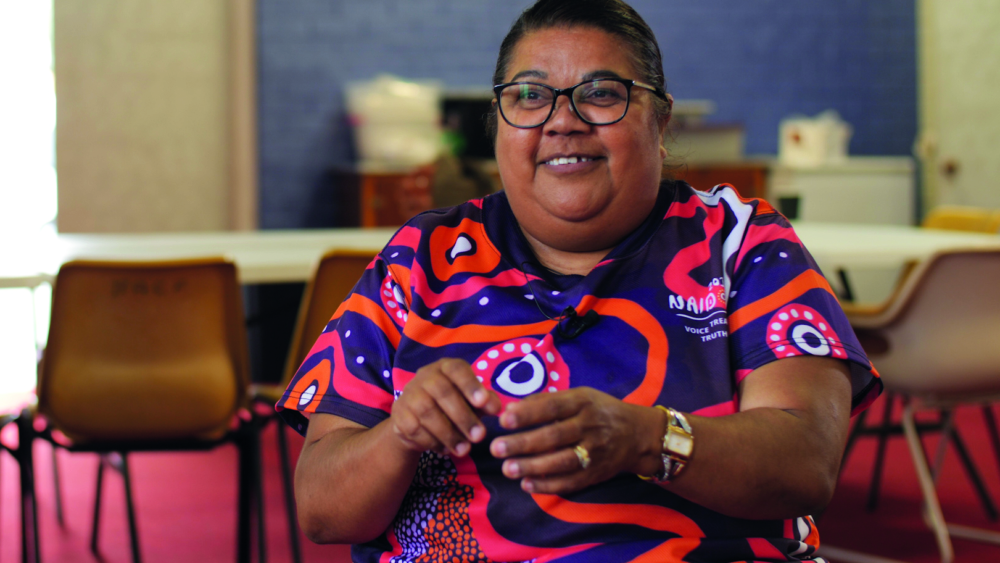Joy and grief of language lost but not forgotten
Nyoongar woman, Charmaine Councillor, loves her language. She teaches Nyoongar to elders who have lost their language.
Actually, Charmaine doesn’t use the word ‘teach’. She sees herself more as a ‘facilitator of language’.
“How do you actually revive a language that’s near extinction?” – Charmaine Councillor
While she is helping others to reclaim an almost lost language, she is not fluent in this endangered language herself. You don’t have to burrow too deep to discover Charmaine’s grief at this.
“According to linguists, for you to be a fluent speaker, you should be able to speak for five to ten minutes in native tongue on any subject, whether it’s imagination, abstract ideas, things happening now, things happening in the past, talking about everyday single events in everyday life,” Charmaine explains.
“I’m not there yet because I still have to rely heavily on English to be able to get the message across.”
The International Year of Indigenous Languages is being celebrated during 2019 and August 9 is International Day of the World’s Indigenous Peoples.
Narrowing in on south-west Western Australia and the language Charmaine loves to preserve and share, Nyoongar was spoken by the various clans of the Nyoongar nation.
It is believed that each of the 14 clans had their own dialect, but now only three are spoken. Very few people would be fluent in them.
“We are the largest one language group within the whole of Australia and we are trying to find strategies on how do you actually revive a language that’s near extinction,” says Chairmaine.
“We like to say ‘gone to sleep’ because we think that the language is still in the land.
“It’s still in parts of people’s memory and it’s actually attached to place names.”
Charmaine has adopted a teaching method developed years ago by native American speakers in California. This language immersion class is called the ‘master and apprentice model’. Part of this model includes a stage called ‘the grief and growl’.
“There has to be a grieving process before you can actually begin to learn language. The ‘grief and growl’ is to be able to tell exactly how you feel when you lose language, talk about trauma.
“It’s your time to growl about it.
“That’s actually the most important part of the Nyoongar language program. You must actually give people time to get it off their chest and say it out in the open.”
Charmaine says that as people in the room remember their stories, there is a shared understanding. Many were punished for speaking in language, or their parents had been put in a mission and had lost their language at that time. She says this process leads to tears, anger, a release of long stored emotion. It can’t be hurried, to enable people to move on from this grief.
Charmaine utilises training tools that are fundamental to Aboriginal DNA. She will bring out her guitar and together the group will sing simple songs in language, or they will tell stories, “allowing elders to spin a yarn”.
The master and apprentice model is particularly helpful for the older Nyoongar people Charmaine works with, whom she describes as being ‘our walking dictionaries’.
“We’re trying to go back to where the Nyoongar people have the knowledge and if we were to embrace that and capture those times that are so rare, we can actually bring back our language and hear the sounds again coming back.”
“Jesus had his language too and he explained his culture through parables, like how we do ours.” – Charmaine Councillor
Charmaine has been a Christian since her teenage years, but it is only as she has taught Nyoongar language that she has realised God is interested in the whole person, including her Aboriginality.
“I kept my Christian life separate but then I started really connecting how our culture and our language is actually woven into Christianity,” explains Charmaine.
“I had to wait until the light came on for myself.
“And then I started looking at Jesus in a different way and I said ‘Jesus is a storyteller. He had his language too and he explained his culture through parables, like how we do ours.”
“Because when you think about it, Jesus is speaking from his culture in the Bible. He was a carpenter. Our mob, we could be talking about making a spear or going hunting or things like that but he would have had his thing … they all talked about sheep, fishermen. We don’t have sheep here but we could talk about kangaroos and emus.”
The Nyoongar translation of the Old Testament book of Ruth is now underway, with support by Bible Society Australia.
The Gospel of Luke was translated into Nyoongar during a 15 year project that culminated in a launch in 2014.
This book is memorably presented as it features Nyoongar on every odd page, and spoken English (translated from the Nyoongar) on the even page. A glossary of words is at the bottom of pages.
For Aboriginal people, reclaiming language is linked to culture, to language and to land. The loss of language has robbed Indigenous people of their identity, their sense of self and of community. The deep emotions attached to language, and why more people are focusing on language centres, comes from a desire to bring healing, hope and restoration to people groups across the world who have been left bereft by language loss.
“What I see is that we have all these different pillars in our society and what threads all those pillars together is a fine thread which is called language. It marries everything together,” Charmaine succinctly puts it.
“One of those drops off and it doesn’t work. If the language falls out, then these things stand separate. But when you stand them together and thread them through, then they stay together and that’s your whole Aboriginality, your culture, your kinship, everything all about you as an Aboriginal person.”

